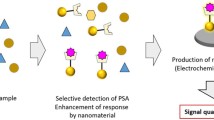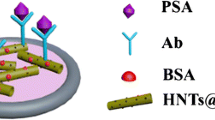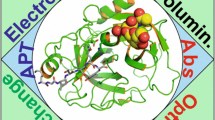Abstract
Prostate cancer is the most common cancer among men except for skin cancer, and the detection at early stages is crucial. In the present work, nanofabricated memristive biosensors are subjected to surface bio-modification targeting at prostate-specific antigen (PSA) IgM detection. The electrical response of the nanofabricated devices examined before and after the bio-modification achieves a label-free detection for three biomarker concentrations. The presence of biomolecules linked to the surface of the nanostructures is detected by a voltage gap appearing in the memristive electrical characteristics. Enzyme-linked immunosorbent assay methodology is further applied to verify the efficiency of the application of diverse biomarker concentrations on the surface. Scanning electron microscopy shows details on the morphology of the nanofabricated structures before and after the bio-modification, and confocal microscopy is implemented to obtain a 3D fluorescent signal distribution of the biomolecules. The system shows the potential for applications in molecular diagnostics and for implementation targeting at the early detection of the prostate cancer disease.





Similar content being viewed by others
References
Lacroix-Desmazes, S., Kaveri, S. V., Mouthon, L., Ayouba, A., Malanchere, E., Coutinho, A., et al. (1998). Self-reactive antibodies (natural autoantibodies) in healthy individuals. Journal of Immunological Methods, 216, 117–137.
Varambally, S., Bar-Dayan, Y., Bayry, J., Lacroix-Desmazes, S., Horn, M., Sorel, M., et al. (2004). Natural human polyreactive IgM induce apoptosis of lymphoid cell lines and human peripheral blood mononuclear cells. International Immunology, 16, 517–524.
Pontisso, P., Calabrese, F., Benvegnu, L., Lise, M., Belluco, C., Ruvoletto, M. G., et al. (2004). Overexpression of squamous cell carcinoma antigen variants in hepatocellular carcinoma. British Journal of Cancer, 90, 833–837.
Beneduce, L., Castaldi, F., Marino, M., Tono, N., Gatta, A., Pontisso, P., et al. (2004). Improvement of liver cancer detection with simultaneous assessment of circulating levels of free alpha-fetoprotein (AFP) and AFP-IgM complexes. The International Journal of Biological Markers, 19, 155–159.
Beneduce, L., Castaldi, F., Marino, M., Quarta, S., Ruvoletto, M., Benvegnu, L., et al. (2005). Squamous cell carcinoma antigen IgM complexes as novel biomarkers for hepatocellular carcinoma. Cancer, 103, 2558–2565.
Pontisso, P., Quarta, S., Caberlotto, C., Beneduce, L., Marino, M., Bernardinello, E., et al. (2006). Progressive increase of SCCAIgM immune complexes in cirrhotic patients is associated with development of hepatocellular carcinoma. International Journal of Cancer, 119, 735–740.
Castaldi, F., Marino, M., Beneduce, L., Belluco, C., De Marchi, F., Mammano, E., et al. (2005). Detection of circulating CEAIgM complexes in early stage (stage 1) colorectal cancer. The International Journal of Biological Markers, 20, 204–208.
Goc, S., & Jankovic, M. (2013). Evaluation of molecular species of prostate-specific antigen complexed with immunoglobulin M in prostate cancer and benign prostatic hyperplasia. Disease Markers, 35(6), 847–855.
Beneduce, L., Prayer-Galetti, T., Giustinian, A. M., Gallotta, A., Betto, G., Pagano, F., et al. (2007). Detection of prostate-specific antigen coupled to immunoglobulin M in prostate cancer patients. Cancer Detection and Prevention, 31(5), 402–7.
Strukov, D., Snider, G., Stewart, D., Williams, S. (2008). The missing memristor found. Nature, 453, 80–83.
Chua, L. (1971). Memristor—the missing circuit element. IEEE Transactions on Circuit Theory, 18(5), 507–519.
Wua, J., & Mc Creery, R. (2009). Solid-state electrochemistry in molecule/TiO2 molecular heterojunctions as the basis of the TiO2 memristor. Journal of the Electrochemical Society, 156(1), 29–37.
Rose, G., Rajendran, J., Manem, H., Karri, R., Pino, R. (2012). Leveraging memristive systems in the construction of digital logic circuits. Proceedings of the IEEE, 100(6), 2033–2049.
Pershin, Y., & Di Ventra, M. (2010). Experimental demonstration of associative memory with memristive neural networks. Neural Networks, 23(7), 881–886.
Indiveri, G., Linares-Barranco, B., Legenstein, R., Deligeorgis, G., Prodromakis, T. (2013). Integration of nanoscale memristor synapses in neuromorphic computing architectures. Nanotechnology, 24, 384010.
Gelencser, A., Prodromakis, T., Toumazou, C., Roska, T. (2012). Biomimetic model of the outer plexiform layer by incorporating memristive devices. Physical Review E, 85, 041918.
Sacchetto, D., Gaillardon, P. E., Zervas, M., Carrara, S., De Micheli, G., Leblebici, Y. (2013). Applications of multi-terminal memristive devices: a review. IEEE Circuits and Systems, 13(2), 23–41.
Gaillardon, P. E., Sacchetto, D., Bobba, S., Leblebici, Y. (2012). GMS: generic memristive structure for non-volatile FPGAs. Santa Cruz: IFIP/IEEE International Conference on Very Large Scale Integration (VLSI-SoC).
Sacchetto, D., Doucey, M. A., De Micheli, G., Leblebici, Y., Carrara, S. (2011). New insight on biosensing by nano-fabricated memristors. BioNanoScience, 1, 1–3.
Carrara, S., Sacchetto, D., Doucey, M. A., Baj-Rossi, C., De Micheli, G., Leblebici, Y. (2012). Applications of multi-terminal memristive devices: a review. Sensors Actuators B: Chemical, 171–172, 449–457.
Patolsky, F., Zheng, G., Lieber, C. M. (2006). Fabrication of silicon nanowire devices for ultrasensitive, label-free, real-time detection of biological and chemical species. Nature Protocols, 1, 1711–1724.
Zhou, X. T., Hu, J. Q., Li, C. P., Ma, D. D. D., Lee, S. T. (2003). Silicon nanowires as chemical sensors. Chemical Physics Letters, 369, 220–224.
Janata, J., & Josowicz, M. (2003). Conducting polymers in electronic chemical sensors. Nature Materials, 2, 19–24.
Zheng, G., Patolsky, F., Cuil, Y., Wang, W., Lieber, C. (2005). Multiplexed electrical detection of cancer markers with nanowire sensor arrays. Nature Biotechnology, 23(3), 12941301.
Stern, E., Vacic, A., Mark, A. R. (2008). Semiconducting nanowire field effect transistor biomolecular sensors IEEE trans. Electronic Devices, 55(11), 31193130.
Puppo, F., Dave, A., Doucey, M. A., Sacchetto, D., Baj-Rossi, C., Leblebici, Y., et al. (2014). Memristive biosensors under varying humidity conditions. IEEE Transactions on NanoBioscience, 13(1), 19–30.
Acknowledgments
The authors gratefully acknowledge the staff of the Cmi Clean Room of EPFL for assisting with technical advice and M. Zervas for the fruitful discussions regarding the fabrication process and G. Knott for the SEM imaging with ZEISS Gemini500.
Author information
Authors and Affiliations
Corresponding author
Additional information
The present work was financially supported by the project PROSENSE receiving funding from the European Union Horizon 2020 research and innovation program under the grant agreement no 317420
Rights and permissions
About this article
Cite this article
Tzouvadaki, I., Parrozzani, C., Gallotta, A. et al. Memristive Biosensors for PSA-IgM Detection. BioNanoSci. 5, 189–195 (2015). https://doi.org/10.1007/s12668-015-0179-4
Published:
Issue Date:
DOI: https://doi.org/10.1007/s12668-015-0179-4




